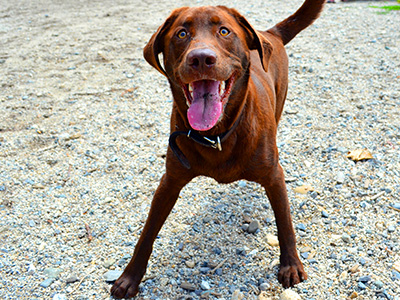Background
It’s all in the name, and it might explain why Laborador Retrievers are so excited to play fetch!
Affectionately known as Labs, Labrador Retrievers hail from 16th century Newfoundland, now part of the Newfoundland and Labrador provinces of Canada, where they were originally used as fishing dogs. They helped fishermen by pulling in nets and chasing and “retrieving” fish that escaped from fishing lines. Over the years, they were crossed with Setters, Spaniels, and other retrievers, and they gradually became efficient “retrievers” of all sorts of game, from birds to rabbits. Today, they’re the most popular breed of dog in the United States, Canada, and the United Kingdom. Sizing Up
Sizing Up
Labs are relatively large, athletic dogs, and typically display these physical traits:
- Weight: 60-88 lbs.
- Height: 22-25 in.
- Coat: Smooth, short, dense, straight
- Color: Black, chocolate brown, or yellow
- Lifespan: 10-13 years
Health
The Labrador Retriever can be at risk for laryngeal paralysis.
What are they like?
Labs are great dogs for active families! They are loyal, loving, patient, and are really good around kids. Smart and eager to please, they are easily trainable and are also a popular choice for service dog work. They are very good swimmers and love to play for hours, and they tend to adjust well to new babies or other household changes that occur in families. Labs also get along well with other animals.
As highly active dogs, Labs do well with active people: running, swimming, and hiking are all great activities for Labs. They are durable and athletic and can keep up during relatively intense physical activities.
While Labs are very healthy, they are prone to the following diseases and conditions:
- Bloat, which can lead to gastric dilatation volvulus (GDV)
- Hip dysplasia and elbow dysplasia
- Knee problems, such as a luxating patella
- Eye problems, such as retinal dysplasia
- Canine Exercise Induced Collapse
Right for you?
Labs are the most popular dog breed for a lot of reasons, but that doesn’t mean they are right for everyone. Here are a few things to consider before bringing home a cute and cuddly Lab puppy:
- Exercise, exercise, exercise! Labs are high-energy dogs and a short walk around the block is rarely enough. You and your family will need to exercise your dog daily – fetch and water-based games are best.
- Do you have a fenced-in yard? Labs need a place to romp and play – without a fenced yard, they tend to wander.
- We all love puppies, but Labs tend to stay puppyish longer than most dogs and don’t mature in personality until around 3 years old. Be ready for this; even though they are highly trainable, you’ll need to be patient.
- Shedding. Labs aren’t long-haired dogs, but they do a fair amount of shedding. If you require a dog hair-free house, a lab might not be the best choice.
Overall, Labs can make great family dogs!
If you have any questions or concerns, you should always visit or call your veterinarian – they are your best resource to ensure the health and well-being of your pets.
